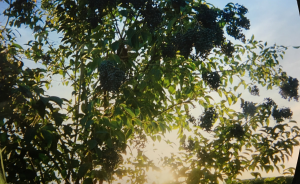By Madeline Joslin, Williamson Preserve Community Engagement Associate AmeriCorps member
Chinese privet (Ligustrum sinense)
 Ligustrum sinese, known commonly as Chinese privet, is of the genus Ligustrum which contains 50 species native to Europe, North Africa, and Asia. European privet and Japanese privet are also invasive, but not as abundant or aggressive in the piedmont of North Carolina as Chinese privet.
Ligustrum sinese, known commonly as Chinese privet, is of the genus Ligustrum which contains 50 species native to Europe, North Africa, and Asia. European privet and Japanese privet are also invasive, but not as abundant or aggressive in the piedmont of North Carolina as Chinese privet.
Chinese privet (hereafter, privet) was introduced to the United States in 1852 as an ornamental shrub and nearly 200 years later, has taken over thousands of acres of North Carolina hardwood bottomlands. It was favored in landscaping for its ability to form dense, fast-growing thickets perfect for hedgerows and fencerows. By 1932, privet had escaped cultivation and naturalized in the Southeastern United States. It can now be found as far west as Texas and as far north as Massachusetts, but remains most prolific in the Southeast.
Privet has become so widespread due to its ability to grow in nearly any condition. It grows in sun, shade, bottomlands, uplands, riparian zones, and suburban areas. Because of its history of being intentionally planted for landscaping, privet can often be seen in suburban settings: yards, roadsides, and forest edges. The plant especially thrives in its preferred conditions of direct sun and moist soils by out-competing native shrubs and blocking smaller herbaceous plants from sunlight.
In winter, privet is easily identifiable by its copious clusters of dark purple drupes. Frugivorous birds love the nutrient-poor fruit, which contain up to 4 seeds each, and act as vectors in dispersing the invasive’s seeds far and wide. Although birds love them, the fruit is poisonous to humans and can cause stomach pain, nausea, and vomiting. White-tailed deer consume young privet plants when preferred vegetation is scarce, but not significantly enough to keep the plant under control.
In late spring, privet boasts panicles of white flowers which many consider to have an unpleasant odor. Although not an effective method of removal, it is advantageous to pick the flowers in spring to hinder fruit production. Privet can be a little more difficult to identify in summer without any distinct fruit or malodorous flowers. It is often seen in understories as a semi-evergreen shrub, but in its preferred conditions can grow unfettered up to 30 feet tall. Privet forms dense thickets with multiple stems sprouting from the trunk each with branches of opposite and ovate leaves that remain throughout winter.
Removal techniques
Removing privet requires a sustained and enthusiastic effort, but can be done. Small plants can be removed by pulling, but it is essential to remove as much of the root system as possible. When cut, the roots and stem promptly sprout suckers, determined to outgrow any other hardwood in its vicinity.
Weed wrenching is an effective mechanical control tool Triangle Land Conservancy deploys to remove larger privet saplings. A weed wrench is a large, steel tool with clamps that can be situated around large samplings. Once the privet trunk has been clamped, the wrench uses leverage to extract the plant out of the soil.
If a plant is too large for a weed wrench and its roots cannot be completely removed, chemical control is necessary. Cutting without applying herbicide will encourage more stump sprouting and exacerbate the issue at hand. Glyphosate herbicides can be applied to cut stumps, foliage, and basal bark in the late summer and fall. However, glyphosate is a nonselective herbicide and will kill any vegetation it touches, making foliar application dangerous for non-target species.
Privet is an unrelenting invasive– making early detection and prevention of privet some of the best control measures– though it can be defeated through persistent removal and herbicide application. It can be found at many Triangle Land Conservancy properties including Williamson Preserve along Walnut Hill Way and west of the white pack barn. A few native alternatives to privet that look similar and have a comparable growth habit include Carolina cherry laurel (Prunus caroliniana), Blackhaw (Viburnum prunifolium), American Olive (Osmanthus americanus), and Bracted Viburnum (Viburnum bracteatum). With your help, we can manage this pesky plant and provide more space for our native species which feed and support our ecosystem.
This blog post was written by Madeline Joslin, member of Resilience Corps NC, an AmeriCorps program run by Conservation Trust for North Carolina and funded through a federal grant awarded by NC’s Commission on Volunteerism and Community Service.


